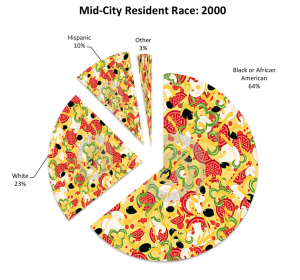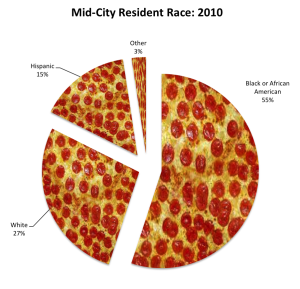In my investigation of Pizza in the Mid-City neighborhood, I found that despite a healthy smattering of local neighborhood pizza places, it also is categorized by a generous offering of national Pizza restaurants as well, which are interestingly all located in very close proximity to one another. According to national market research, national chains take only 35% of the pizza market share in the United States with the majority of business going to smaller local pizzerias, which also abound in Mid-City.
Pizza Hut, Papa John’s Pizza, and Domino’s Pizza are conveniently all clustered around the intersection of N. Carrollton and Bienville Ave and have all joined Mid-City’s Restaurant Row rather recently. Domino’s was the first to open its doors in 2007, followed by Papa John’s in 2012 and most recently Pizza Hut in 2013 with the opening of the new Mid-City Mall. Domino’s, Pizza Hut, and Papa John’s have very similar business models, which keeps them in close competition for their share of the Mid-City pizza market.

Domino’s Pizza is the leader amongst pizza chains with regards to online and mobile ordering and delivery. This is reflected in the built environment of the Domino’s located in Mid-City. With several reserved parking spots and very few tables inside the actual restaurant, it is clear that Domino’s is catering to the Mid-City take-out crowd. Its location right on N. Carrollton Ave, puts it perfect position for commuters looking for food on their way home.

Because of its diverse menu options (pizzas, sandwiches, pastas, chicken, and flavored breads), Domino’s as a corporation, has seen consistent growth over the last decade, despite its inability to respond to consumer demand for more healthy choices. Domino’s main focus for growth according to a 2013 SWOT analysis is expanding into emerging markets in India and China. This is a sentiment shared by most fast-food restaurants not already engaged in those markets.
Domino’s employees and management at the Mid-City location continuously declined interviews and thus a deeper look into this particular location was impossible.
Papa John’s moved to its Mid-City location in 2012 following the shuffling of several business that shared space within the strip mall. Prior to Katrina, the space currently occupied by Papa John’s was first Sounds Warehouse Music and Movies, which was bought out by Blockbuster just months before the neighborhood’s devastation.

Similar to the Domino’s located just across the street, Papa John’s Pizza has easy access to reserved parking. It too has limited dining facilities inside the building and thus also caters to the take-out eaters of the neighborhood and surrounding area. Unlike Domino’s, however, Papa John’s offers only the most basic pizza options and are known mostly for their garlic butter dipping sauce which accompanies every pie. With 4,200 locations, Papa John’s is the smallest of the national pizza chain restaurants present in Mid-City. Similar to Domino’s, however, Papa John’s employees and management were also unenthusiastic about answering questions and sharing their thoughts on the role and relevance of their restaurant in the Mid-City food cluster.
Pizza Hut is the largest global chain represented in the Mid-City neighborhood of New Orleans. The fast-food pizza chain boasts more than 20,000 franchises all around the world and although in their 2013 SWOT analysis, they recognized consumer satisfaction with their pizza is in decline, they chain continues to seek out new ways to stay competitive. Part of this strategy includes WingStreet, a major marketing strategy of the Mid-City location, especially during Saints Football Season! WingStreet is a menu of chicken wings available at most Pizza Hut locations.

A similar challenge faced by competitors Papa John’s and Domino’s Pizza Hut has struggled to adjust to the increase in public awareness around the adverse effects of eating high fat/high calorie diets, like pizza. As a business model Pizza Hut can not compete with the fresher and sometimes more local ingredients that other neighborhood pizza chains such as Theo’s and Crescent Pie & Sausage Company offer their customers.
 The reality that these three chains have come to Mid-City in the post-Katrina context is not surprising. This kind of business development is a trend that can be seen all around the city, from the stirrings of a Chipotle opening on Magazine Street to the commodification of New Orleans culture seen throughout the French Quarter. Due to the physical and economic devastation that hurricane Katrina brought upon the City of New Orleans, locally-based business faced competition from national corporations that were left unscathed.
The reality that these three chains have come to Mid-City in the post-Katrina context is not surprising. This kind of business development is a trend that can be seen all around the city, from the stirrings of a Chipotle opening on Magazine Street to the commodification of New Orleans culture seen throughout the French Quarter. Due to the physical and economic devastation that hurricane Katrina brought upon the City of New Orleans, locally-based business faced competition from national corporations that were left unscathed.
These businesses represent one extreme of the creolization-to-Americanization food culture spectrum. The food is predictable, available quickly, affordable, and familiar to people all across the world. These pizza chains represent a tension that can be seen throughout the city of New Orleans because of their proximal competition with local chains. Pizza Hut, Papa John’s, and Domino’s represent the highly-Americanized end of the spectrum and as a result appeal to a limited audience.
posted by Arianna King

 Just one year ago, Mid-City said goodbye to longtime pizza spot
Just one year ago, Mid-City said goodbye to longtime pizza spot




































